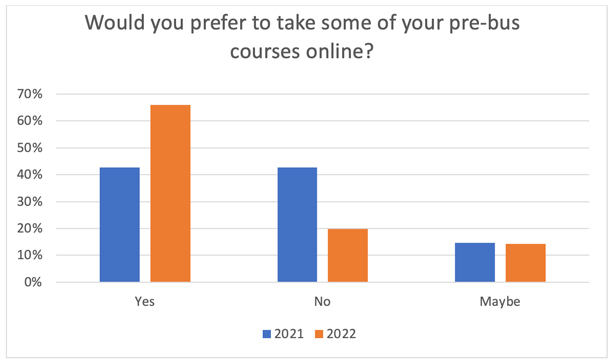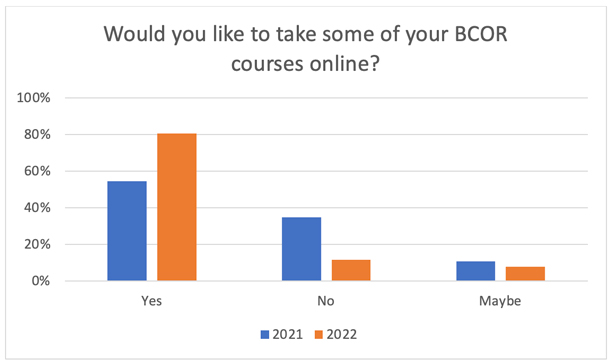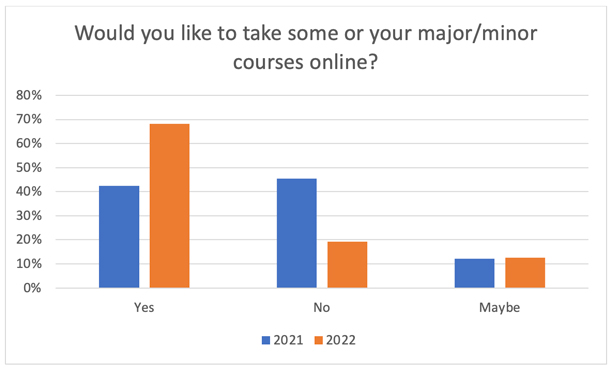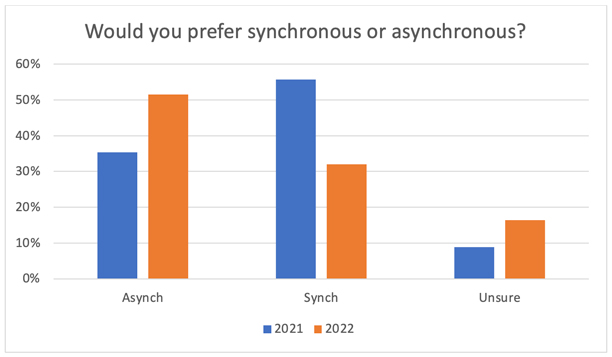
Introduction
Like a great many other institutions, we emerged from the pandemic knowing that the disruptions of the last few years would inevitably lead to changes in the preferences and desires of our student population around the educational model and how education gets delivered. We also knew that, to remain successful and competitive as an undergraduate program of ~2,900 students in a typical college of business at a large, public land-grant institution, we needed to keep in close touch with how those preferences were evolving. This article serves to tell that story: how we went about understanding our students’ changing attitudes about the educational model, what the data pointed to, and what changes we made in response. Students now clearly prefer to have online classes in all areas of their curricula, and they prefer asynchronous offerings over synchronous – a large change from what our data was telling us just one year ago.
We hope that by telling this story, we urge and inspire other units to do the same: not only is it important to continually monitor and adjust to best meet your constituents’ needs, but those who are willing to adapt quickly have a distinct opportunity to take advantage of the changing landscape of education.
The “return to normal” year
As we stated in our original piece, even prior to the pandemic, more and more on-campus students were requesting to take asynchronous online courses that were only available in our online programs. These options allow students to spend less time on campus or work more hours during the day while maintaining full-time status. While we have offered online courses for several years, placing an entire program online in less than two weeks was a shock to the system and led to several student issues including dissatisfaction with paying nonresident tuition for online courses, frustration over the way some courses were converted, and a lack of interaction with faculty. However, we learned as we moved through the pandemic, and moving to more synchronous offerings in Spring 2021 led to fewer student complaints.
For the 2021-22 academic year, we “returned to normal” with face-to-face courses for on-campus students. Initially, online classes were reserved for online-only students. However, many regular offerings remained in an online format when it became clear that this was desired by the students. This also served the needs of the faculty as many requested to work from home for reasons of health or convenience. Last year’s survey results helped us to create a “new normal”, with greater online offerings for students and faculty, rather than simply return to the way things were before the pandemic.
Surveying our students to learn how their preferences have changed
In order to gain a better understanding of the impact of the “return to normal” year and how student preferences were evolving, we distributed a survey via email in March 2022 to 2,671 on-campus undergraduate students. The survey was left open for three weeks, and 533 responses were received (a 19.96% response rate compared to a 25.95% response rate in 2021). As in 2021, the number of responses in each major was generally comparable to our student population, with seniors filling in the largest percentage of questionnaires followed by juniors, sophomores, and freshmen. The response rates were biased towards our higher performing students, with almost 50% of respondents self-reporting a GPA of over 3.5 and only 20% self-reporting a GPA under 3.0.
Our pre-business curriculum consists of eight or nine courses (depending on major): six are business (accounting, economics, and business computer applications) while the others are composition courses and applied calculus. These courses are typically completed during the first three semesters. We saw a significant change in student preference from 2021 to 2022. While students were evenly split between wishing to take pre-business courses online or face-to-face immediately following the online pandemic year, students now prefer the online option by a three-to-one margin, with 339 responding “YES” and 102 responding “NO” (73 said “MAYBE”).

When asking students about their business core courses (BCOR–the typical courses taken by all students in the college covering the major areas of finance, marketing, management, information systems, supply chain management, etc.), there was a similar result. While a clear majority preferred to take BCOR courses online in 2021, the new results show a huge increase in that sentiment, with an overwhelming 80% responding “YES” as opposed to only 54% previously.

Finally, while most students previously preferred to take their major/minor courses in a face-to-face format, we also saw a large swing, with a strong majority now preferring some of their courses to be online.

Yet another major change was the desired format of online classes, where the preference swung significantly from synchronous to asynchronous. Despite the apparent success of our online synchronous courses near the end of the pandemic lockdown, after a year of returning to campus, students now prefer their online options to be asynchronous in format.

Our reactions
The findings confirmed the suspicions we’d had based on anecdotal evidence and student requests for future semesters. During the pandemic, we thought that students would prefer asynchronous options, but were surprised to find more support for synchronous offerings in our initial survey. However, it is clear that student views have changed significantly over the past year, and the vast majority now favor the asynchronous format. Apart from the obvious convenience of allowing students to hold jobs and internships, participate in extracurricular activities, etc. while also completing their coursework, we theorize that this preference for asynchronous learning is due to the fact that students are now taking some classes face-to-face and participating in more normal college activities, providing much greater interaction with faculty and students than during the year of lockdown. It’s one thing to want synchronous offerings when all of your classes have been moved online, but another altogether when students have returned to campus.
Another possible factor is the improvement in our asynchronous offerings. One benefit of the lockdown year was the significant knowledge gained around online pedagogy, particularly in asynchronous courses. We believe that our asynchronous courses are now more desirable to students due to the simple fact that we have improved our delivery significantly.
What did surprise us is the large swing in preference for online courses in all areas of the curriculum, particularly in major and minor courses. Students have clearly become comfortable with taking courses online in all aspects of their programs, and now wish to have those options readily available.
These results provide guidance for increasing student satisfaction, and possibly performance and retention, in future semesters. We originally intended to offer more synchronous courses in the pre-business and BCOR programs but elected to keep most major and minor courses in a face-to-face format. However, what these results indicate to us is that students want a combination of some face-to-face courses AND asynchronous offerings in all areas of their curricula. This may also provide better job satisfaction for employees, many of whom have become productive in a hybrid environment where they work some days in the office and others at home.
In closing
While the 2021-22 academic year may have been billed as a “return to normal”, the truth is that we are still moving to a “new normal”. A year of lockdowns and virtual campuses changed student expectations for the foreseeable future, and those expectations evolved during the past year of more face-to-face interaction. As educators and academics, we would be remiss if we did not take the opportunity to properly study what has taken place and adjust our future offerings in an effort to make the educational experience more rewarding and convenient for our students. Disruptions can be painful in the short term but can also be areas of opportunity for forward-looking organizations that are willing to adapt.
We plan to continue surveying our students in future semesters, to further gather their views on educational preferences. The experience of the past two years has significantly improved our ability to offer class material in an online format that is engaging and rigorous in both synchronous and asynchronous formats. Convenience cannot trump our ability to educate; the best-case scenario is a selection of course offerings that caters to the current student’s demands in the new environment, while also ensuring that learning meets and exceeds the standards to which we hold ourselves. Those institutions that find the proper balance will succeed at a time when student populations are forecast to decline nationwide.
In closing, we urge you to talk to your students and gather information on their preferences, as your students may have differing views. Academia must continue to evolve to meet student, employee, and employer needs, and surveys like the one we deployed are a simple and effective way to gain the data you need to plan for what will inevitably be the future “new normal”.



